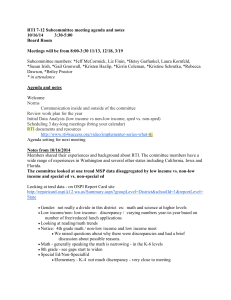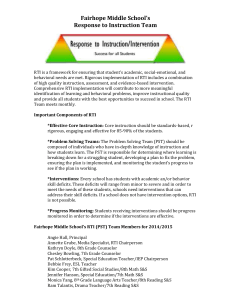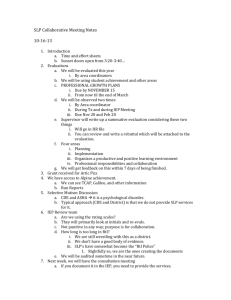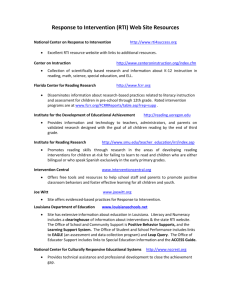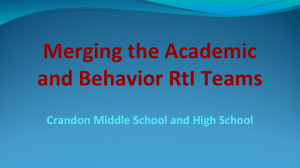2/6/15 Special Ed Subcommittee Meeting Notes
advertisement
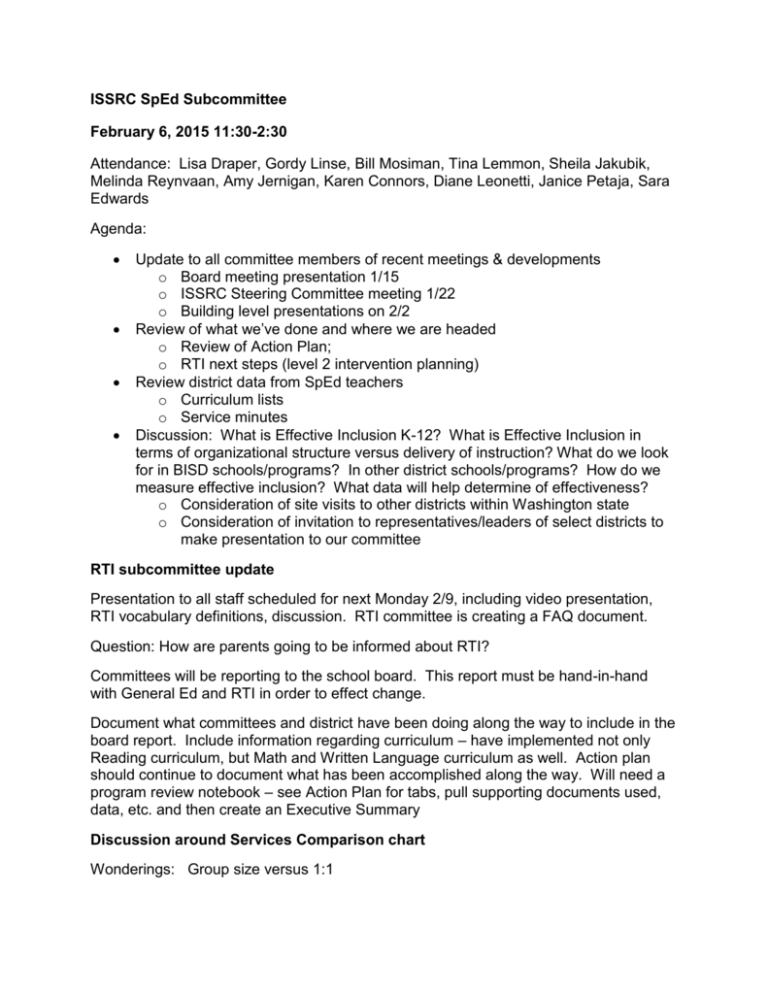
ISSRC SpEd Subcommittee February 6, 2015 11:30-2:30 Attendance: Lisa Draper, Gordy Linse, Bill Mosiman, Tina Lemmon, Sheila Jakubik, Melinda Reynvaan, Amy Jernigan, Karen Connors, Diane Leonetti, Janice Petaja, Sara Edwards Agenda: Update to all committee members of recent meetings & developments o Board meeting presentation 1/15 o ISSRC Steering Committee meeting 1/22 o Building level presentations on 2/2 Review of what we’ve done and where we are headed o Review of Action Plan; o RTI next steps (level 2 intervention planning) Review district data from SpEd teachers o Curriculum lists o Service minutes Discussion: What is Effective Inclusion K-12? What is Effective Inclusion in terms of organizational structure versus delivery of instruction? What do we look for in BISD schools/programs? In other district schools/programs? How do we measure effective inclusion? What data will help determine of effectiveness? o Consideration of site visits to other districts within Washington state o Consideration of invitation to representatives/leaders of select districts to make presentation to our committee RTI subcommittee update Presentation to all staff scheduled for next Monday 2/9, including video presentation, RTI vocabulary definitions, discussion. RTI committee is creating a FAQ document. Question: How are parents going to be informed about RTI? Committees will be reporting to the school board. This report must be hand-in-hand with General Ed and RTI in order to effect change. Document what committees and district have been doing along the way to include in the board report. Include information regarding curriculum – have implemented not only Reading curriculum, but Math and Written Language curriculum as well. Action plan should continue to document what has been accomplished along the way. Will need a program review notebook – see Action Plan for tabs, pull supporting documents used, data, etc. and then create an Executive Summary Discussion around Services Comparison chart Wonderings: Group size versus 1:1 Definition of Indirect services: indirect services are determined by location; these are SDI service provided in the general ed Discussion: Caseload is a bargaining issue. We can give bargaining team information for their work. Gordy may be able to provide some comparison information to the bargaining team, including information regarding caseload language from district with blended funding and RTI. Yet Gordy recommends being careful about scripting out caseload with too much definition, and need to recognize teachers in needs. Trust needs to be maintained between administration and teachers in order to determine what is appropriate/reasonable. Also need to recognize a need for equity in the system that provides student services, teacher responsibilities, and programs. Type of program you have will drive how you count students, etc. If doing more blending, such as SpEd teacher spending more time in classroom, this may help in long run with retaining SpEd teachers when program numbers are low – teacher can assist with the blended/Tiered instruction. Looking at average minutes: Wonderings: why are there differences between average minutes in buildings? This is possibly due to teacher strengths. However, looking at numbers can help shine light if there are differences n LRE, how students are being placed/served and are students being removed from GenEd unnecessarily. Additional Data: look at LRE coding, look at range of minutes (0-225, 225-500, etc.) instead of average minutes, high school in GenEd data – what might be going on?, Staffing - number of teachers, number of paras, group size Class scheduling can have an impact on group size. Scheduling will become more challenging with science specialist beginning next year. During what times/activities can students be pulled in order to receive SDI? Next Steps: Look at philosophy around how to determine when SDI is delivered. Need to look at consistency amongst schools. This is a good conversation for Steering Committee because it may be impacted with RTI implementation. Question for IEP Online/Goalview – what kind of data are we able to pull in order to look more closely at service minutes and programs. Curriculum List High school teachers are looking for additional curriculum/support. Julie is working towards curriculum for HS level. HS admin is developing courses for struggling learners. Need to look at para training within the curriculum list. Create a curriculum map that includes all Tiers I, II, III Where is additional training needed? – add to action plan. Parking Lot: Look at intensive, targeted instruction – several weeks, not all semester or year – explore RTI Effective Inclusion practices Other district view: (in-state): Franklin-Pierce (Bill Raslica), White River (Mike Jacobson), Mercer Island, Issaquah (assessment coordinator), Spokane (Steve Hirsh), Vancouver? Also Richland Idea: Join with RTI committees, bring panel from other districts to discuss with us: progress, barriers, etc. Develop set of questions for these reps… “RTI SUMMIT” possible questions: How far are you away from moving away from discrepancy model? If White River has been doing this the longest, why have you not moved to RTI identification model? What are the immediate barriers you are facing? Bring together a panel of RTI-users to discuss their process/progress into RTI, successes, barriers. – RTI Summit o Panel in morning; full group discussion in afternoon o What questions will we ask of them. o Check on 3/11 or 3/12 Internal view: facilitated by Gordy and Val Look internally at Effective Inclusive Practices K-12 What are Effective Inclusive Practices K-12? What is Effective Inclusion in terms of organizational structure versus delivery of instruction? What do we look for in BISD schools/programs? In other district schools/programs? How do we measure effective inclusion? What data will help determine of effectiveness? Use data (service distribution and curriculum) to drive questions Develop smart questions for Gordy/Val to ask during internal view. SpEd Subcommittee members will generate questions to submit to Gordy and Val. They will consolidate, generating guiding questions and make observations, such as: How much do you know about RTI? Where are you at with regards to RTI? What are the strengths and barriers to inclusive practices? How do we establish continuity of SpEd service delivery across district? Look at services at each building determine similarities/differences Gordy/Val will meet with focus groups: SLPs; psychs; OT/PT; SpEd teachers at separate buildings (Sakai SpEd teachers, Ordway SpEd teachers) Email questions to Diane by Monday 2/9. Next Meeting: March 12 8:00-2:30 – pending scheduling of RTI Summit – Board Room Thursday April 9th, 8:00-2:30 – Board Room

